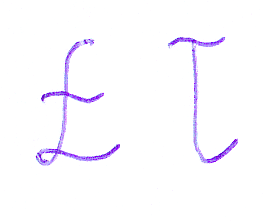Ł facts for kids
Quick facts for kids Ł ł |
|
|---|---|
|
Letter L with stroke
|
|
| Other names | Letter L with Middle Tilde |
| In Unicode | Error using : Input "0141" is not a hexadecimal value. Error using : Input "0142" is not a hexadecimal value. |
Ł or ł, often called L with stroke in English, is a special letter found in the alphabets of several languages. It's most famous for its use in Polish, Kashubian, and Sorbian. You'll also find it in Navajo, Inupiaq, and some other languages. This letter helps show different sounds that are similar to the regular "L" sound.
Contents
What Ł Looks Like
When you see Ł in printed text, it has a short line or "stroke" going through the middle of the letter. This stroke usually crosses the letter at a slight angle, not straight across.
However, when people write Ł by hand, or in fonts that look like handwriting, the capital letter Ł can look a lot like the pound sign (£). The stroke on the small letter ł is usually placed on top of the letter, not through the middle. This helps make sure it doesn't look like the letter 't'. The stroke can be straight or a little wavy, depending on the writing style.
Ł in Polish Language
In Polish, the letter Ł is very important. It helps tell apart two different "L" sounds that used to exist. One was a "dark L" (like the "L" in "pull" in English), and the other was a "clear L" (like the "L" in "light").
Over time, the sound of Ł in Polish changed. Today, most Polish speakers pronounce Ł like the English "W" sound, as in the word "water." So, if you hear a Polish word with Ł, it will often sound like it has a "W" instead. For example, the Polish word słowo (meaning "word") is pronounced like "swovo."
This change in pronunciation happened gradually. It started with some people in the 16th century and became common by the mid-20th century. Even though the sound changed, the letter Ł is still used to show where that "dark L" sound used to be.
Sometimes, Ł can change to a regular "L" when a word changes its form. For example, the Polish word mały (meaning "small" for a male person) has an Ł. But its plural form, mali (meaning "small" for a group of males), uses a regular "L."
When you can't type Ł, like on some older computers or online, people sometimes use a regular "L" instead. Polish speakers usually understand what is meant, even without the special stroke. In the 1980s, some computers in Poland even used the pound sterling sign (£) as a stand-in for Ł because the correct character wasn't available!
Famous People and Words with Ł
Many famous Polish people have Ł in their names:
- Marie Skłodowska Curie: A brilliant scientist who won Nobel Prizes in both physics and chemistry.
- Karol Józef Wojtyła: He was the Pope of the Catholic Church for many years.
- Kazimierz Pułaski: A Polish soldier who became a general in the American Revolutionary War.
- Ignacy Łukasiewicz: He invented the modern paraffin lamp, which was a big step for lighting.
- Lech Wałęsa: A Polish labor leader and a former president of Poland.
- Stanisław Lem: A famous Polish writer known for his science fiction stories.
- Wisława Szymborska: A Polish poet who won the Nobel Prize in Literature.
Here are some common Polish words that use Ł:
- Władysław (a common Polish name)
- Wisła (the longest river in Poland)
- Łódź (a large city in Poland)
- Łukasz (the Polish version of the name Lucas or Luke)
- Michał (the Polish version of the name Michael)
- Złoty (the currency of Poland)
Ł in Other Languages
Besides Polish, Ł is used in other languages for different sounds:
- In Belarusian (when written with Latin letters), Ł usually sounds like the "L" in English words like "pull."
- In Navajo and Elaponke, Ł makes a sound that's like a "voiceless L." It's similar to the "Ll" sound in Welsh.
- In some Athabaskan languages spoken in Alaska, like Ahtna and Tanacross, Ł is used for a special "breathy" L sound.
- Sometimes, Ł is used when writing Armenian words using Latin letters. It can represent a sound that was once like the "L" in "pull" but has changed over time.
Ł and Computers
When you're using computers, each letter has a special code. For Ł, the Unicode codes are U+0141 for the capital letter and U+0142 for the small letter. This helps computers around the world display the letter correctly.
If you're using a special writing system like LaTeX (which is used for making scientific documents), you can type Ł and ł using simple commands like `\L{}` and `\l{}`.
See also
 In Spanish: Ł para niños
In Spanish: Ł para niños
- Ў, ў – short U (Belarusian Cyrillic)
- £ – pound sign
- In Venetian, a similar letter ⟨Ƚ⟩, ⟨ƚ⟩ (L with bar, with a horizontal bar) is used for "L" sounds that have changed in some dialects.
Images for kids




